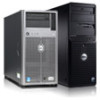Dell PowerEdge M520 Brocade M5424 Blade Server SAN I/O Module Hardware Referen - Page 29
Operating the SAN I/O Module, Interoperability, Port negotiation
 |
View all Dell PowerEdge M520 manuals
Add to My Manuals
Save this manual to your list of manuals |
Page 29 highlights
Chapter Operating the SAN I/O Module 3 This chapter describes the operation and interoperability of the SAN I/O Module. Interoperability The SAN I/O Module supports interoperability for the following functions: • link initialization • soft WWN zoning • principal SAN I/O Module selection • routing (FSPF) • Simple Name Service • state change notification • SNMP facilities • translative mode (private target support on fabrics) • trunking (between two Brocade switches) • Advanced Performance Monitoring Port negotiation The SAN I/O Module has been designed to be highly interoperable. Eight Gbps ports support 2, 4, and 8 Gbps transmit and receive rates with autonegotiation. You can also install 4 Gbps SFPs, which allow 1 Gbps, 2 Gbps, and 4 Gbps transmit and receive rates with autonegotiation. The actual data signaling rate used on a port is automatically sensed and set to the rate supported by the device or devices attached to the port. NOTE You must install Brocade-branded SFPs in the SAN I/O Module. If the SAN I/O Module is connected to a device, but is unable to negotiate the signaling rate, the operator can manually set the speed of each port through the management interfaces. The SAN I/O Module is compliant with current Fibre Channel standards, including most current-generation switch N_Ports, NL_Ports, and E_Ports as well as host adapters, Redundant Array of Independent Disks (RAID) storage devices, hubs, Fibre-SCSI bridge devices, and older switch families. M5424 SAN I/O Module Hardware Reference Manual 19 53-1001082-01















